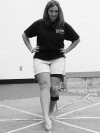Patellar taping, patellofemoral pain syndrome, lower extremity kinematics, and dynamic postural control
- PMID: 18335009
- PMCID: PMC2231393
- DOI: 10.4085/1062-6050-43.1.21
Patellar taping, patellofemoral pain syndrome, lower extremity kinematics, and dynamic postural control
Abstract
Context: Patellar taping has been a part of intervention for treatment of patellofemoral pain syndrome (PFPS). However, research on the efficacy of patellar taping on lower extremity kinematics and dynamic postural control is limited.
Objective: To evaluate the effects of patellar taping on sagittal-plane hip and knee kinematics, reach distance, and perceived pain level during the Star Excursion Balance Test (SEBT) in individuals with and without PFPS.
Design: Repeated-measures design with 2 within-subjects factors and 1 between-subjects factor.
Setting: The University of Toledo Athletic Training Research Laboratory.
Patients or other participants: Twenty participants with PFPS and 20 healthy participants between the ages of 18 and 29 years.
Intervention(s): The participants performed 3 reaches of the SEBT in the anterior direction under tape and no-tape conditions on both legs.
Main outcome measure(s): The participants' hip and knee sagittal-plane kinematics were measured using the electromagnetic tracking system. Reach distance was recorded by hand and was normalized by dividing the distance by the participants' leg length (%MAXD). After each taping condition on each leg, the participants rated the perceived pain level using the 10-cm visual analog scale.
Results: The participants with PFPS had a reduction in pain level with patellar tape application compared with the no-tape condition (P = .005). Additionally, participants with PFPS demonstrated increased %MAXD under the tape condition compared with the no-tape condition, whereas the healthy participants demonstrated decreased %MAXD with tape versus no tape (P = .028). No statistically significant differences were noted in hip flexion and knee flexion angles.
Conclusions: Although patellar taping seemed to reduce pain and improve SEBT performance of participants with PFPS, the exact mechanisms of these phenomena cannot be explained in this study. Further research is warranted to investigate the effect of patellar taping on neuromuscular control during dynamic postural control.
Keywords: McConnell taping; anterior knee pain.
Figures




References
-
- McConnell J. The management of chondromalacia patellae: a long-term solution. Aust J Physiother. 1986;32(4):215–223. - PubMed
-
- Ernst GP, Kawaguchi J, Saliba E. Effect of patellar taping on knee kinetics of patients with patellofemoral pain syndrome. J Orthop Sports Phys Ther. 1999;29(11):661–667. - PubMed
-
- Gigante A, Pasquinelli FM, Paladini P, Ulisse S, Greco F. The effects of patellar taping on patellofemoral incongruence: a computed tomography study. Am J Sports Med. 2001;29(1):88–92. - PubMed
-
- Harrison EL, Sheppard MS, McQuarrie AM. A randomized controlled trial of physical therapy treatment programs in patellofemoral pain syndrome. Physiother Can. 1999;51(2):93–106.
Publication types
MeSH terms
LinkOut - more resources
Full Text Sources
Other Literature Sources
Medical

